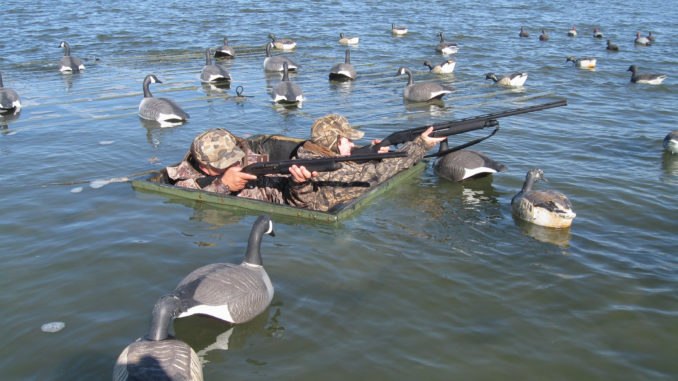
Many hunters place curtain blinds in the same category as sink boxes, but that is not accurate.
Sink boxes, which are illegal, are floating devises that allow hunters to hide below the level of the water. Curtain blinds, which are legal, are pit blinds sunk in sandbars that have an adjustable top section (the curtain), which can be raised or lowered according to the stage of the tide. They may allow hunters to hide below water level, but they are permanent. They must also be permitted by the county, and not all counties allow them.
The curtain is height adjustable and is positioned to keep the water from lapping over into the blind. The ideal position for the curtain is just high enough above the water level. Some hunters say this is an inch, while some want a second inch for added security.
What makes a curtain blind so effective is that approaching ducks and geese can’t see the hunters, even when they are sitting in the middle of the decoy spread. With no big box above the water to hide the hunters, decoys around a curtain blind appear to be resting in open water. Once the ducks or geese are in range, the hunters stand up and shoot. It is total surprise.
A second part of the curtain blind is a wooden latticework frame, called a wing, that surrounds the blind box on at least two sides. The wing is positioned into the wind and breaks down the swell so it doesn’t splash over into the blind. Decoys are placed on the wing to break up its outline and add concealment.
Curtain blinds are not large. Rom Whitaker’s curtain blind is 4×4 feet and just deep enough for hunters to see out without the ducks seeing in. It is large enough two hunters in waders and winter clothing. The seat is a 2×8 board also used as a step to enter and leave the blind that can be positioned to face in any direction. Anything carried into the blind should be in a waterproof container or pocket and there is just enough room under the seat to store two 5-gallon buckets.
Editor’s note: This story is part of the article titled Curtains on Hatteras waterfowl in the December issue of North Carolina Sportsman magazine, now available on newsstands or in a new digital edition.




Be the first to comment